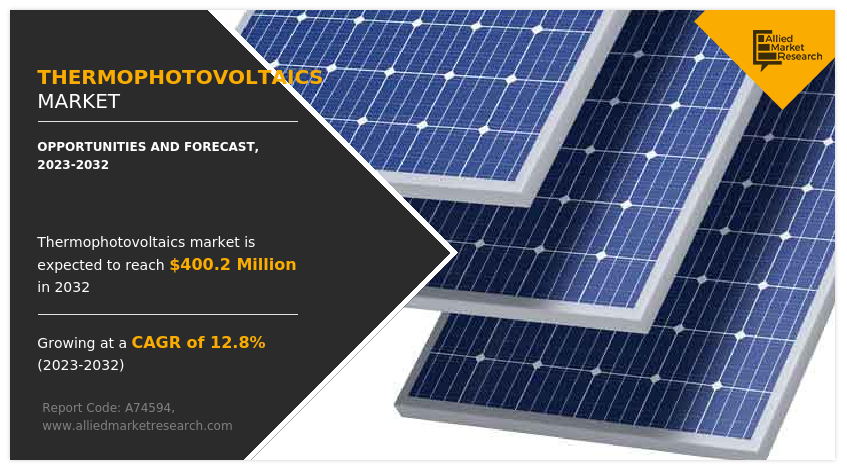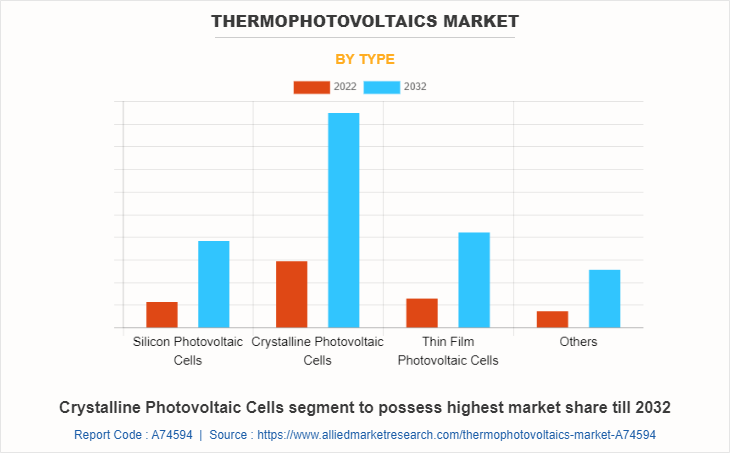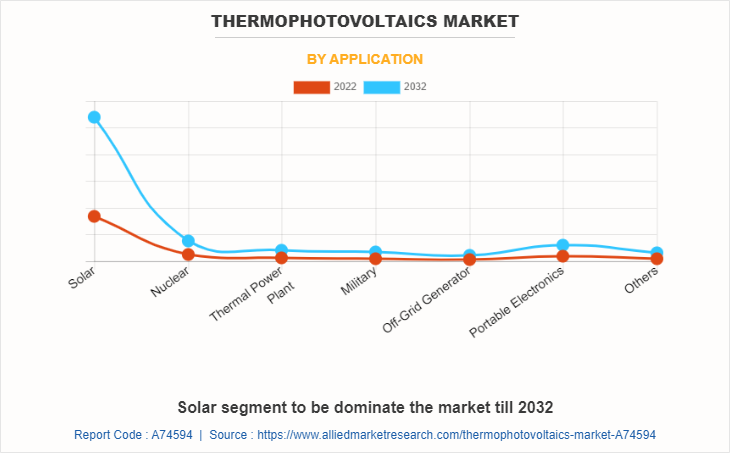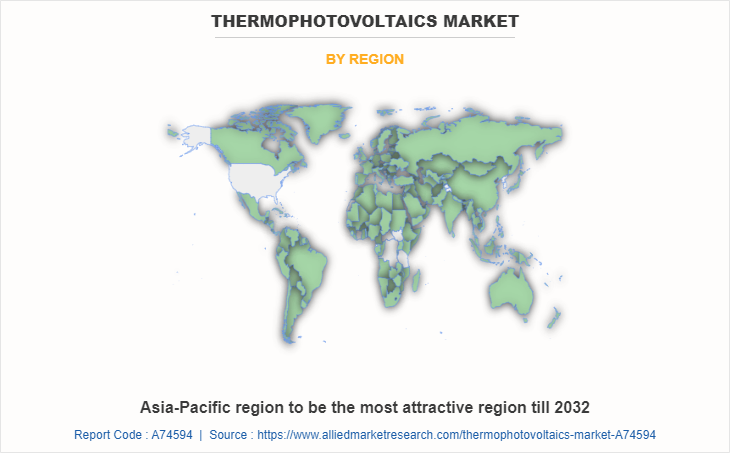Thermophotovoltaics Market Research, 2032
The global thermophotovoltaics market size was valued at $120.3 million in 2022, and thermophotovoltaics industry is projected to reach $400.2 million by 2032, growing at a CAGR of 12.8% from 2023 to 2032.

Thermophotovoltaics (TPV) is an emerging technology that converts thermal radiation into electricity through photovoltaic cells. It offers a solution for various applications, which include waste heat recovery, solar power generation, and portable energy systems. The increase in interest in TPV has spurred significant advancements in this field, driven by the need for efficient energy conversion and utilization.
The industrial sector has recognized the potential of TPV for waste heat recovery, which enables the conversion of excess heat into usable electricity. This application is particularly relevant in industries with high-temperature processes, such as steel, cement, and glass production. TPV systems capture and convert this waste heat, reduce energy consumption, and enhance overall energy efficiency.
Solar power generation is another area where TPV holds promise, as it harnesses the sun's thermal radiation, TPV technology is utilized to convert solar heat into electricity and complement traditional photovoltaic systems. This approach offers advantages in situations where direct sunlight is limited, such as in cloudy or shaded environments. TPV operates at higher temperatures and expands its potential for concentrated solar power systems. Portable energy systems, which include remote sensors and off-grid power solutions, are expected to benefit from TPV technology. These systems require self-sustainability and reliable power sources. TPV devices, with their compact size and ability to convert ambient heat into electricity, are expected to provide a viable solution to power these applications in remote or harsh environments.
Despite its potential, the thermophotovoltaics market growth faces certain challenges such as low efficiency and high cost of infrastructure. One of the key areas of focus is an increase in the efficiency of TPV devices. Furthermore, the need for enhancement of the conversion efficiency of thermal radiation to electricity is crucial to maximize energy generation and improve the overall performance of TPV systems. Ongoing research aims to develop advanced materials and designs that are expected to achieve higher conversion efficiencies.
"Solar Applications in Thermophotovoltaics: Harness Solar Energy for Efficient Electricity Generation"
Solar applications in the thermophotovoltaics (TPV) market refer to the utilization of solar energy as a primary heat source in TPV systems. Thermophotovoltaics is a technology that converts heat energy into electricity and utilizes a combination of thermal radiation and photovoltaic cells.
In TPV systems, concentrated solar radiation is used to generate high-temperature heat, typically in the range of 1,000 to 2,500 degrees Celsius. This concentrated heat is then directed toward a thermal emitter, which emits thermal radiation in the form of photons. Photovoltaic cells, optimized for specific wavelengths, are placed in the path of this thermal radiation to convert it into electricity. Solar applications in the TPV market are categorized into two main types, solar TPV and Hybrid TPV. Solar TPV system uses concentrated solar energy as the primary heat source. Concentrated solar power (CSP) technologies, such as parabolic troughs, solar power towers, or dish concentrators, are employed to focus sunlight onto a receiver. The concentrated solar radiation is then used to generate high-temperature heat, which is subsequently converted into electricity through the TPV process.
Hybrid TPV systems, both solar energy and an additional fuel source are used to provide the required heat. Solar energy is typically used during daylight hours, while additional fuel, such as natural gas or biomass, is used to supplement thermal energy generation during nighttime or periods of low solar radiation. This hybrid approach ensures continuous operation and improved efficiency of the TPV system.
"Unlocking Sustainable Power: Nuclear Applications in Radioisotope Thermophotovoltaics"
Nuclear energy holds potential applications in the thermophotovoltaics (TPV) market, specifically in the form of radioisotope thermophotovoltaic (RTPV) systems. RTPV combines the principles of nuclear decay heat and TPV technology to convert the heat generated by radioactive isotopes into electricity.
In RTPV systems, a radioactive isotope with a high-energy decay process, such as plutonium-238 or strontium-90, is used as the heat source. The heat produced from the radioactive decay process is absorbed by a TPV converter, which then converts thermal radiation into electricity through photovoltaic cells. This process offers a unique way to harness the abundant energy released during the decay of radioactive isotopes.
Nuclear applications in the thermophotovoltaics market forecast, particularly through radioisotope thermophotovoltaic (RTPV) systems, offer numerous advantages. RTPV systems provide long-lasting and reliable power with radioactive isotopes with extended half-lives, which makes them ideal for applications that require sustained energy generation in remote or space missions. These systems benefit from the high energy density of radioactive isotopes, enabling the development of compact and lightweight TPV converters suitable for space-constrained environments. Moreover, RTPV systems enhance safety through sealed and encapsulated designs, minimize the risk of radiation exposure, and reduce long-term environmental impact.
They enable the utilization of waste heat from nuclear reactors and improve the overall efficiency and energy output of nuclear power plants. However, safety and regulatory considerations, as well as the limited availability of suitable isotopes, present challenges that need to be addressed for the widespread deployment of RTPV technology.
The thermophotovoltaics market scope is segmented on the basis of type, application, and region. On the basis of type, it is categorized into silicon photovoltaic cells, crystalline photovoltaic cells, thin film photovoltaic cells, and others. On the basis of application, it is classified into solar, nuclear, thermal power plant, military, off-grid generator, portable electronics, and others. On the basis of region, the thermophotovoltaics market is analyzed across North America, Europe, Asia-Pacific, and LAMEA.

On the basis of type, silicon photovoltaic cells dominate the thermophotovoltaics market. This segment occupies nearly half of the global thermophotovoltaics market share in terms of revenue. This is primarily due to its large-scale commercialization and low cost of production compared to other photovoltaic cells. However, crystalline photovoltaic cells segment is expected to grow at a significant CAGR due to its advantages such as higher efficiency for power generation compared to conventional photovoltaics.

On the basis of application, the solar segment dominates the thermophotovoltaics market. This segment has nearly three-fifths of the global market share in terms of revenue. It is primarily due to an increase in awareness among consumers regarding the utilization of thermophotovoltaics with various already existing power generation facilities. However, the other segment is expected to grow at a significant CAGR due to an increase in the application of TPV technology in the satellite and space industries with nuclear power sources.

On the basis of region, Asia-Pacific is the major consumer of thermophotovoltaics among other regions. It accounted for more than half of the global market share in 2022. Asia-Pacific is made up of developing and underdeveloped countries and is also the most populated region across the globe. It is also home to a considerable number of megacities and an increase in population. It is expected to have the largest urban population by 2050; in addition to this, the fact that more than 70% of the buildings expected to stand in India in 2030 are yet to be built.
Impact of Russia-Ukraine on Global Thermophotovoltaics Market
The Russia-Ukraine conflict has the potential to impact the thermophotovoltaics (TPV) market in several ways. Disruptions in the supply chain due to trade restrictions or transportation issues could affect the production and availability of TPV systems. Instability in the energy markets, particularly regarding natural gas, may influence the cost-effectiveness and competitiveness of TPV technology. Geopolitical uncertainty due to the conflict could create caution among investors, and potentially impact decisions to invest in emerging technologies such as TPV. Changes in regional energy policies and priorities due to the conflict may also influence the adoption of TPV systems. In addition, collaborative research, and development efforts in the field of TPV between Russia, Ukraine, and other countries may be hindered if political tensions escalate.
Impact of Global Recession on Global Thermophotovoltaics Market
A global recession has significant implications on the thermophotovoltaic (TPV) market. During economic downturns, investment in recent technologies tends to decrease as companies and investors prioritize financial stability over long-term projects. This reduced fund hinders research and development (R&D) activities in the TPV sector and slows down advancements and innovation. Furthermore, a recession often leads to decreased market demand for energy solutions, which makes it challenging for TPV systems to gain traction and widespread adoption. Delays or cancellations of planned TPV projects are also common during economic uncertainty, as companies prioritize cost-cutting measures. Government priorities may shift towards economic recovery, and potentially impact the level of support and incentives available for renewable energy technologies such as TPV. In addition, supply chain disruptions caused by trade restrictions and financial challenges faced by suppliers affect the availability and cost of TPV components.
Competitive Landscape
The major companies profiled in this report include MicroLink Devices, Azur Space Solar Power, Spectrolab, Schott AG, Alta Devices, Tesla Energy, Acciona SA, Abengoa Solar GmbH, BrightSource, and ACWA Power. Governments across the globe have set sights on the development of renewable energy sources, which require high energy density storage batteries.
Key manufacturers have innovated and expanded their production capacities to meet market demand across the globe due to the rapid increase in demand for energy in recent years. Additional growth strategies such as new product developments, acquisition, and business expansion strategies are adopted to attain key developments in the thermophotovoltaics market trends. Several countries have initiated pilot projects related to thermophotovoltaics (TPV) to explore the technology's potential and feasibility as mentioned below:
U.S.:
The U.S. Department of Energy's Advanced Research Projects Agency-Energy (ARPA-E) has supported TPV research projects. One notable initiative is the MOSAIC (Micro-scale Optimized Solar-cell Arrays with Integrated Concentration) program, which aims to develop TPV systems capable of the conversion of high-temperature heat into electricity efficiently. The University of California, San Diego (UCSD) conducted pilot projects on TPV and explored its applications in waste heat recovery and power generation from concentrated solar thermal systems.
Germany:
The Fraunhofer Institute for Solar Energy Systems (ISE) in Germany has been involved in TPV research and pilot projects. They have focused on developing TPV systems that convert the heat generated by gas burners into electricity, which potentially is expected to improve the efficiency of combined heat and power (CHP) systems. The Technical University of Munich (TUM) conducted R&D on TPV technology and explored its potential applications in various industries.
Japan:
The National Institute of Advanced Industrial Science and Technology (AIST) in Japan has worked on TPV research projects, particularly focused on high-temperature TPV systems. They aim to develop TPV devices that convert concentrated solar thermal energy into electricity with high efficiency. The University of Tokyo conducted pilot projects on TPV, exploring its applications in waste heat recovery and power generation from industrial processes.
Netherlands:
The Delft University of Technology in the Netherlands has been involved in TPV research and development. The university has explored the use of TPV technology for converting concentrated solar thermal energy into electricity, as well as its potential in waste heat recovery.
China:
Tsinghua University in China conducted research and pilot projects on TPV, focused to develop TPV systems that efficiently convert waste heat into electricity. Their work aims to improve energy efficiency and reduce emissions in industrial processes.
Key Benefits For Stakeholders
- This report provides a quantitative analysis of the market segments, current trends, estimations, and dynamics of the thermophotovoltaics market analysis from 2022 to 2032 to identify the prevailing thermophotovoltaics market opportunities.
- The market research is offered along with information related to key drivers, restraints, and opportunities.
- Porter's five forces analysis highlights the potency of buyers and suppliers to enable stakeholders make profit-oriented business decisions and strengthen their supplier-buyer network.
- In-depth analysis of the thermophotovoltaics market segmentation assists to determine the prevailing market opportunities.
- Major countries in each region are mapped according to their revenue contribution to the global market.
- Market player positioning facilitates benchmarking and provides a clear understanding of the present position of the market players.
- The report includes the analysis of the regional as well as global thermophotovoltaics market trends, key players, market segments, application areas, and market growth strategies.
Thermophotovoltaics Market Report Highlights
| Aspects | Details |
| Market Size By 2032 | USD 400.2 million |
| Growth Rate | CAGR of 12.8% |
| Forecast period | 2022 - 2032 |
| Report Pages | 245 |
| By Type |
|
| By Application |
|
| By Region |
|
| Key Market Players | Tesla, Inc., ACWA Power International S.A.O.C., MicroLink Devices, Schott AG., Azur Space Solar Power, Brightsource, Abengoa Solar GmbH, Acciona SA, Alta Devices, Inc., Spectrolab |
Analyst Review
According to CXOs perspective, the thermophotovoltaics (TPV) market is poised for remarkable growth due to an increase in awareness among individuals and businesses about the advantages of this energy conversion technology. TPV offers high efficiency to convert heat into electricity, making it an attractive option for various applications. TPV technology has the potential to revolutionize energy through the efficient conversion of waste heat from industrial processes and power generation into electricity. This addresses the surge in the need for sustainable energy solutions and promotes energy efficiency in various sectors.
Governments worldwide actively support the adoption of clean energy technologies, which includes TPV, through incentives and regulations. This favorable regulatory environment and emphasis on reducing carbon emissions drive the demand for TPV systems across industries.
Asia-Pacific presents many opportunities for TPV manufacturers, as countries such as China, Japan, and South Korea focus on their renewable energy infrastructure. These countries invest in R&D to enhance TPV efficiency and commercial viability, which fuels market growth. The escalating demand for energy-efficient solutions in sectors such as manufacturing, power generation, and transportation acts as a significant driver for the global TPV market. Major industry players actively invest in R&D to improve TPV system performance, enhance integration capabilities, and lower costs.
Despite the positive outlook, the widespread adoption of TPV faces certain challenges. The initial cost of TPV systems remains a significant barrier, particularly for large-scale implementations. In addition, concerns related to the environmental impact of TPV production and ensuring efficient recycling and disposal processes are essential to be addressed for sustainable growth in the market.
Increase in demand for energy and renewable energy policies are the key factors boosting the Thermophotovoltaics market growth.
Advancements in TPV technology is the Main Driver of Thermophotovoltaics Market.
MicroLink Devices, Azur Space Solar Power, Spectrolab, Schott AG, Alta Devices, Tesla Energy, Acciona SA, Abengoa Solar GmbH, BrightSource, and ACWA Power
Solar application is projected to increase the demand for Thermophotovoltaics Market
The thermophotovoltaics market forecast is segmented on the basis of type, application, and region. On the basis of type, it is categorized into silicon photovoltaic cells, crystalline photovoltaic cells, thin film photovoltaic cells, and others. On the basis of application, it is classified into solar, nuclear, thermal power plant, military, off-grid generator, portable electronics, and others. On the basis of region, the thermophotovoltaics market is analyzed across North America, Europe, Asia-Pacific, and LAMEA.
The market value of Thermophotovoltaics in 2032 is expected to be $400.2 million
Loading Table Of Content...
Loading Research Methodology...



